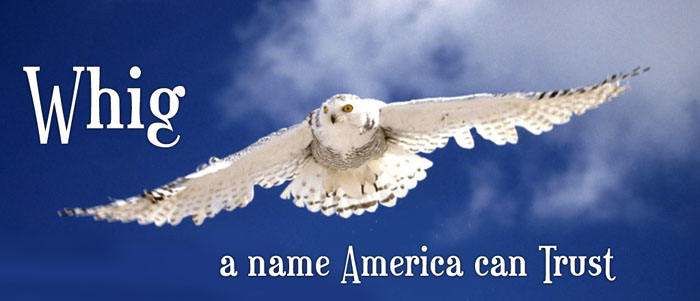Whig
| Whigs | |
|---|---|

| |
| Slogan | SLOGAN |
| Nation | NAL |
| Founded | 1833 (approx.) |
| Headquarters | Philadelphia |
| Current Membership | NUMBER OF MEMBERS |
| Representation | 102 Deputies, 47 Senators |
| Key People | Albert Arnold Gore, Jr. (Leader), Rhoberth Bolton, etc. |
| Political Outlook | Centre-left |
The Whig Party is one of the oldest political parties within the NAL. It dates back to before 1833, when it elected its first General Moderator of the NAL. At that time, its central tenet was the primacy of Parliament over the General Moderator, and its major opposition for most the next century and a half was the Conservative Democrat Party. Towards the end of the 19th century, the Whigs had become (ironically enough) the party of the status quo, and was directly responsible for legislation such as the Sedition Act of 1874 (which led to the Crisis of 1875). In general they sought to suppress the power of labor and of Socialism in general. This changed during the 1920s under the leadership of Gwilliam Lyon MacDowell, who in effect led the Party to political victories by helping create and then taking credit for new social programs--a policy continued by his successor.
By 1990, the Right Wing of the Whig Party had essentially faded away, defecting to other parties such as the Progressive Conservative. With the administration of William Clinton and even moreso of Albert Gore, the Party was increasingly identified as the most Left Wing of the League's major parties, dominated at that time by the so-called NeoLeft.
"Whig" comes from the Scots word whiggam, a term used in driving horses and whiggamore one who drives horses. In England these became associated with those who viewed Parliament as primary before the throne, shortened to "Whig." Americans with a similar political viewpoint adopted the name.
Owls became associated with the Whig Party during the first half of the 19th century, usually as a disparaging nickname, implying that Whigs were nocturnal, silent, predatory and fed upon vermin like mice. It remained in common usage at least in part because it offered considerable possibilities in caricature. However, it was Abrom Lincoln who began to use the Owl as a personal totem or mascot. This was a politically shrewed move as Native citizens (i.e. voters) were far less likely to view the owl as a pest. Likewise, succeeding generations of politicos used owls as symbols of wisdom--noting that Athena, patron goddess of the first democracy Athens, was also symbolized by an owl. By the 1940s the use of mascots in NAL political life had solidified and the owl permanently associated with the Whig Party. At conventions, unofficial "hootings" of approval or disdain were not uncommon. Likewise, increasingly the Whig National Committee authorized using the Snow Owl in advertising, which led by the late 1960s to another nickname for the Whigs--namely, the Whites. This was, however, not a positive development since the Anti-Snorist Movement was gaining ground and the color had unpleasant associations. After the change in Russia's government, however, this side-effect faded.
In structure, the Whigs have undergone numerous changes but currently most authority is vested in the Whig Federal Committee, consisting the Chairs and Vice-Chairs of each Whig Provincial Committee as well as all Whig MPs and the highest ranking Whig elected official from each provincial government. On a day-to-day basis the Central Whig Committee runs the affairs of the party. The WFC elects a Whig Party Chair for the Central Committee -- a post traditionally held by the General Moderator if a Whig and by the Party Leader at other times. Usually the actual work of the Chair is then carried out by the Federal Vice Chair.
General Moderators who have belonged to the Whig Party are:
- Johnathan Taylor 1833-1843
- Abram Lincoln 1863-1873 (later member of the High Court)
- George Brinton McClellan 1973-1875 (assassinated)
- Rutherford Beauford Fogg 1875-1885
- Gwilliam Lyon MacDowell 1921-1931
- Franklin Donald Rosenberg 1931-1949
- Ruth Rosenberg 1949
- Ronald William Regan 1980-1981 (succeeded upon the assassination of James Wainwright, filling out Wainwright's term)
- Ben Nighthorse Campbell 1981-1991
- William Josiah Clinton 1991-2001
- Albert Arnold Gore, Jr. 2001-2011
Other prominent Whigs in American politics have included:
- Thomas Dewey of Castreleon New
- Arnold Shicklegruber, Senator from Jacobia
- Zebediah Miller, former Lord Governor of Jacobia
- Tomos Watson, former Lord Governor of Jacobia
- Louis Arquette, former Moderator of Ontario
- Edgar Allan Powell, former Moderator of Ontario
- Dean R. Cox, former Moderator of Ontario
- Ion Edwards, Delegate from Carolina, former Minister of Health and Public Welfare and former Foreign Secretary
- Hannah Coultier, former Delegate from Pennsylvaania
- Racquel Maddow, Delegate from Massachussets Bay
- Michael Ignatoff, former Lieutenant Moderator of New Yorkshire, Ontario
